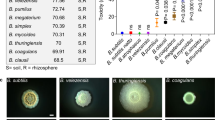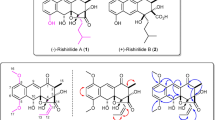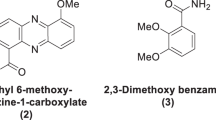Abstract
Piceamycin, a new macrolactam polyketide antibiotic, was detected by HPLC-diode array screening in extracts of Streptomyces sp. GB 4-2, which was isolated from the mycorrhizosphere of Norway spruce. The structure of piceamycin was determined by mass spectrometry and NMR experiments. It showed inhibitory activity against Gram-positive bacteria, selected human tumor cell lines and protein tyrosine phosphatase 1B.
Similar content being viewed by others
Log in or create a free account to read this content
Gain free access to this article, as well as selected content from this journal and more on nature.com
or
References
Hohmann, C. et al. Albidopyrone, a new α-pyrone-containing metabolite from marine-derived Streptomyces sp. NTK 227. J. Antibiot. 62, 75–79 (2009).
Garbaye, J. Biological interactions in the mycorrhizosphere. Experientia 47, 370–375 (1991).
Whipps, J. M. Microbial interactions and biocontrol in the rhizosphere. J. Exp. Bot. 52, 487–511 (2001).
Tarkka, M. T. & Hampp, R. Secondary metabolites of soil streptomycetes in biotic interactions. In Secondary Metabolites in Biotic Interactions in Soil (ed Karlosvski, P.) pp 107–126 (Springer, Berlin, 2008).
Riedlinger, J. et al. Auxofuran, a novel metabolite that stimulates the growth of fly agaric, is produced by the mycorrhiza helper bacterium Streptomyces AcH 505. Appl. Environ. Microbiol. 72, 3550–3557 (2006).
Keller, S., Schneider, K. & Süssmuth, R. D. Structure elucidation of auxofuran, a metabolite involved in stimulating growth of fly acaric, produced by the mycorrhiza helper bacterium Streptomyces AcH 505. J. Antibiot. 59, 801–803 (2006).
Lehr, N.-A., Schrey, S. D., Hampp, R. & Tarkka, M. T. Root inoculation with a forest soil streptomycete leads to locally and systemically increased resistance against phytopathogens in Norway spruce. New Phytol. 177, 965–976 (2008).
Williams, S. T., Goodfellow, M. & Alderson, G. Genus Streptomyces Waksman and Henrici 1943, 339AL. In Bergey's Manual of Systematic Bacteriology (eds Williams, S.T. et al) Vol. 4, pp 2452–3492 (Williams & Wilkins, Baltimore, 1989).
Manfio, G. P., Zakrzewska-Czerwinska, J., Atalan, E. & Goodfellow, M. Towards minimal standards for the description of Streptomyces species. Biotekhnologiya 8, 228–237 (1995).
Fiedler, H.-P. Biosynthetic capacities of actinomycetes. 1. Screening for novel secondary metabolites by HPLC and UV-visible absorbance spectral libraries. Nat. Prod. Lett. 2, 119–128 (1993).
Hatsui, T., Nojima, C. & Takeshita, H. Structure elucidation of the pyrolysates formed by ‘retro-benzylic acid rearrangement’ of the proto-photocycloadducts of methy 2,4-dioxopentanoate-olefins. Bull. Chem. Soc. Jpn. 62, 2932–2938 (1989).
Bolvig, S., Duus, F. & Hansen, E. Tautomerism of enolic triacetylmethane, 2-acyl-1,3-cycloalkanediones, 5-acyl meldrum's acid and 5-acyl-1,3-dimethylbarbituric acids studied by means of deuterium isotope effects on 13C chemical shifts. Magn. Reson. Chem. 36, 315–324 (1998).
Hadden, C. E., Martin, G. E. & Krishnamurthy, V. V. Constant time inverse-detection gradient accordion rescaled heteronuclear multiple bond correlation spectroscopy: CIGAR-HMBC. Magn. Reson. Chem. 38, 143–147 (2000).
Hamaguchi, T., Sudo, T. & Osada, H. RK-682, a potent inhibitor of tyrosine phosphatase, arrested the mammalian cell cycle progression at G1 phase. FEBS Lett. 372, 54–58 (1995).
Ômura, S., Nakagawa, A., Shibata, K. & Sano, H. The structure of hitachimycin, a novel macrocyclic lactam involving β-phenylalanine. Tetrahedron Lett. 23, 4713–4716 (1982).
Umezawa, I. et al. A new antitumor antibiotic, stubomycin. J. Antibiot. 34, 259–265 (1981).
Gilpin, M. L., Fulston, M., Payne, D., Cramp, R. & Hood, I. Isolation and structure determination of two novel phenazines from a Streptomyces with inhibitory activity against metallo-enzymes, including metallo-β-lactamase. J. Antibiot. 48, 1081–1085 (1995).
Van Huijsduijnen, R. H., Bombrun, A. & Swinnen, D. Selecting protein tyrosine phosphatases as drug targets. Drug Discovery Today 7, 1013–1019 (2002).
Grever, M. R., Shepartz, S. A. & Chabner, B. A. The National Cancer Institute: cancer drug discovery and development program. Semin. Oncol. 19, 622–638 (1992).
Acknowledgements
Financial support from the Deutsche Forschungsgemeinschaft (Graduate College 685 ‘Infection Biology’; DS, JR), the European Commission (project ACTINOGEN, 6th framework, Grant LSHM-CT-2004-005224; RDS), and Bayer Schering Pharma AG (Berlin, Germany) is gratefully acknowledged. We thank Dr Thomas Paululat, Universität Siegen, for helpful discussions and for performing the CIGAR-NMR experiments, and Ms Gaby Biegert, Universität Tübingen, for isolation of streptomycetes strains from rhizospheric soils.
Author information
Authors and Affiliations
Corresponding authors
Additional information
Art. no. 50 in ‘Biosynthetic Capacities of Actinomycetes’. Art. no. 49: see Hohmann et al.
Rights and permissions
About this article
Cite this article
Schulz, D., Nachtigall, J., Riedlinger, J. et al. Piceamycin and its N-acetylcysteine adduct is produced by Streptomyces sp. GB 4-2. J Antibiot 62, 513–518 (2009). https://doi.org/10.1038/ja.2009.64
Received:
Revised:
Accepted:
Published:
Issue date:
DOI: https://doi.org/10.1038/ja.2009.64
Keywords
This article is cited by
-
Antimicrobial properties of endophytic actinomycetes isolated from Combretum latifolium Blume, a medicinal shrub from Western Ghats of India
Frontiers in Biology (2015)
-
Endophytic actinobacteria of medicinal plants: diversity and bioactivity
Antonie van Leeuwenhoek (2015)
-
Staurosporine from the endophytic Streptomyces sp. strain CNS-42 acts as a potential biocontrol agent and growth elicitor in cucumber
Antonie van Leeuwenhoek (2014)
-
Biotransformation of the Fungal Phytotoxin Fomannoxin by Soil Streptomycetes
Journal of Chemical Ecology (2013)
-
Silvalactam, a 24-membered macrolactam antibiotic produced by Streptomyces sp. Tü 6392
The Journal of Antibiotics (2012)



